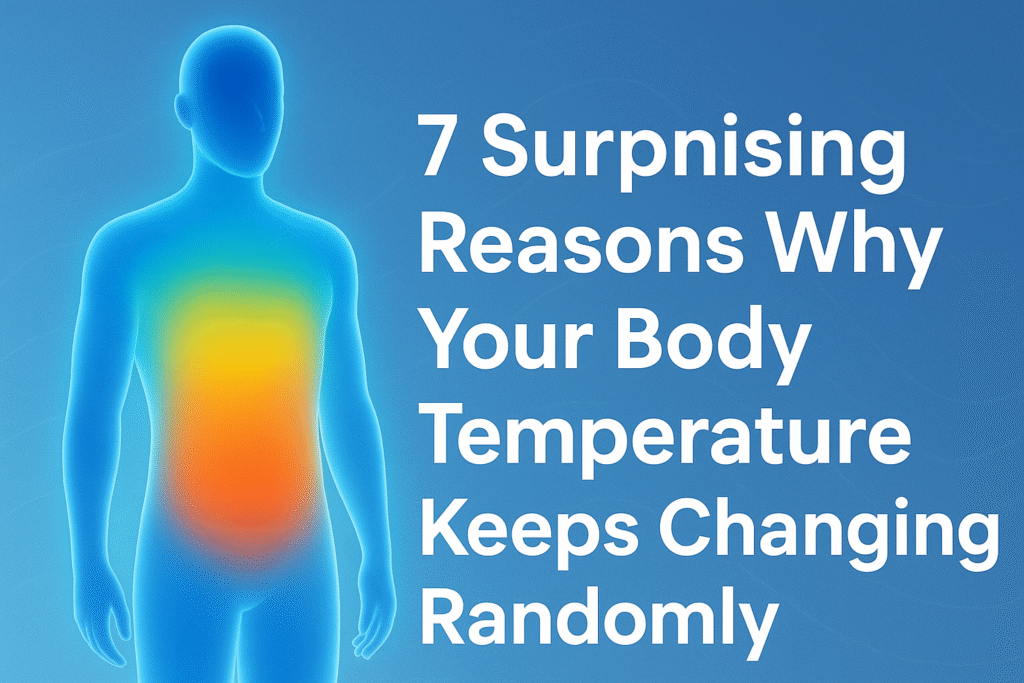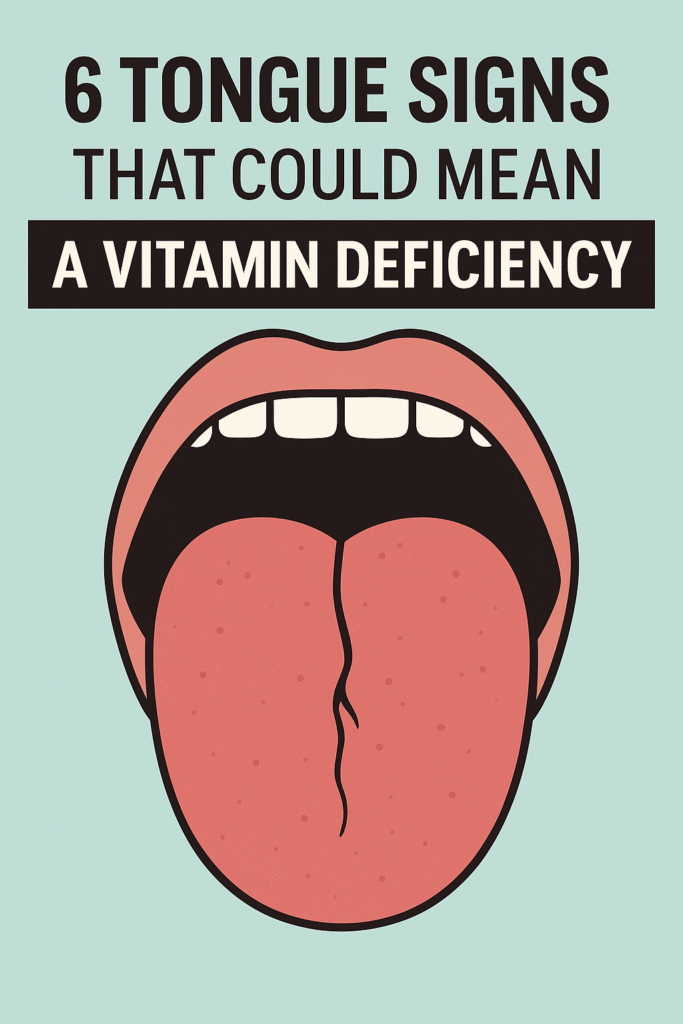
⚠️ Affiliate Disclaimer: This post may contain affiliate links, which means I may earn a small commission — at no extra cost to you — if you make a purchase through one of these links. I only recommend products or services I genuinely trust and believe can provide value. Thank you for supporting My Medical Muse!
7 Surprising Reasons Why Your Body Temperature Keeps Changing Randomly
Your body temperature doesn’t always stay the same, you might feel chilly one minute and overheated the next, even when the room temperature hasn’t changed. While slight fluctuations are normal, random changes can be confusing or even uncomfortable.
This article explores why your body temperature keeps changing randomly, what’s normal, what’s not, and how to restore balance.
How Body Temperature Works
Your body has a built-in thermostat, the hypothalamus, located deep within your brain. It constantly monitors and adjusts your internal temperature to keep it around 37°C (98.6°F). When you get too hot, your body triggers cooling mechanisms such as:
- Sweating, to release heat through evaporation
- Dilating blood vessels near the skin, allowing heat to escape
When you’re cold, the opposite happens:
- Shivering generates heat through muscle activity
- Blood vessels constrict, conserving warmth in your core
This automatic system is influenced by a variety of factors, hormones, stress, circulation, metabolism, and even hydration levels.
That’s why you can sometimes feel random waves of hot or cold for no clear reason.
1. Hormonal Fluctuations
Your hormones have a powerful influence on your body’s thermostat. Even small changes in hormone levels can shift how your body perceives temperature.
In Women
- Menstrual Cycle: After ovulation, the hormone progesterone slightly raises body temperature. You might feel warmer during the luteal phase and cooler right before your period begins.
- Menopause or Perimenopause: Fluctuating estrogen levels can confuse the hypothalamus, leading to hot flashes and night sweats.
- Pregnancy: Increased blood volume and a higher metabolic rate make you feel warmer than usual.
In Men
- Low Testosterone: Can reduce metabolism and circulation, making you feel cold more easily.
- Thyroid Hormones: Both an overactive thyroid (hyperthyroidism) and an underactive thyroid (hypothyroidism) can cause unpredictable changes in body temperature.
What to Do
Track your symptoms, note when you feel hotter or colder and what might trigger it.
If the fluctuations are frequent, intense, or disruptive, ask your doctor for hormonal and thyroid testing. Balancing these systems often restores temperature stability.
2. Circulation and Blood Flow Issues
Your body depends on healthy blood circulation to distribute heat evenly. Warm blood from your core flows through arteries to the skin, hands, and feet, helping regulate temperature. When circulation slows or becomes restricted, certain areas like your hands, feet, or legs may feel unusually cold, while other areas stay warm. This uneven distribution can make your temperature feel unpredictable throughout the day.
Why Circulation Problems Affect Temperature
If blood flow isn’t consistent:
- Heat stays trapped in your core, while your limbs feel cold
- Less oxygen and nutrients reach the skin, leading to cool or pale extremities
- You might even experience sudden hot-and-cold sensations as your blood redistributes
These sensations often worsen after sitting for long periods, staying still, or being in air-conditioned environments.
Common Causes of Poor Circulation
- Prolonged Sitting or Inactivity
Sitting for hours, at a desk, in a car, or in front of a screen causes blood to pool in your lower body. This can make your legs and feet feel cold or tingly, especially if you rarely move around during work hours. - Peripheral Artery Disease (PAD)
PAD occurs when arteries narrow due to plaque buildup, reducing blood flow to the limbs.
Common signs include cold feet, calf pain when walking, and pale or bluish toes. It’s more common in smokers, diabetics, and older adults. - Low Blood Pressure
When your blood pressure drops, your body redirects circulation toward vital organs like the brain and heart.
The result? Cold hands, lightheadedness, and sudden chills, especially after standing up or skipping meals. - Dehydration
Blood is about 90% water. When you’re dehydrated, your blood thickens slightly, making it harder for your heart to pump efficiently.
This can cause inconsistent warmth, sudden flushing, or temperature dips. - Anemia (Low Iron Levels)
Low iron means fewer red blood cells to transport oxygen. This slows metabolism and makes you feel cold, weak, or dizzy even in warm weather.
Anemia is especially common in menstruating women and people with low-protein diets. - Diabetes or Nerve Damage (Neuropathy)
Poorly controlled blood sugar can damage small nerves and blood vessels, disrupting the body’s ability to sense and regulate heat.
You might notice cold feet, numb toes, or alternating warmth and tingling.
What to Do
- Stay Hydrated: Aim for at least 2 liters of water daily to keep your blood circulating smoothly.
- Move Every Hour: If you sit often, stand, stretch, or take short walks to keep blood flowing.
- Avoid Smoking: Nicotine constricts blood vessels, worsening cold sensations.
- Eat Circulation-Boosting Foods: Add garlic, ginger, dark chocolate, and leafy greens for vascular health.
- Check Your Heart and Blood Vessels: If you often feel cold in specific body parts, especially if there’s numbness or discoloration ask your doctor about circulation testing or Doppler ultrasound scans.
In short:
If one part of your body is always cold while the rest feels normal, it’s often a sign of poor circulation rather than an actual drop in core body temperature. Fixing blood flow and hydration usually helps you feel more balanced overall.
3. Stress, Anxiety, and the “Fight or Flight” Response
Your body’s temperature isn’t just controlled by physical processes, your emotions and stress levels also play a big role.
When you’re stressed, anxious, or frightened, your brain activates the “fight or flight” response, a survival mechanism that’s been hardwired into humans for thousands of years.
This response triggers the release of adrenaline and cortisol hormones designed to help you react quickly to danger.
However, they also cause a temporary redistribution of blood and alter how your body senses temperature.
You might feel:
- Sudden heat or facial flushing: Blood rushes to your muscles and skin as your body prepares to “fight” or “run.”
- Cold chills or shivering: Once adrenaline levels drop, your body rapidly rebalances, leading to a cool, shivery sensation.
- Cold sweats: Anxiety activates sweat glands even when you’re not hot. Your body tries to cool itself despite a normal temperature.
Over time, chronic stress can desensitize your nervous system, making temperature regulation unpredictable, warm when calm, cold when anxious.
What to Do
- Practice Deep Breathing or Meditation: Slow breathing helps deactivate the “fight or flight” system.
- Keep Your Environment Comfortable: A cool, well-ventilated room prevents overheating during anxiety spikes.
- Ground Yourself Daily: Engage in activities that regulate your nervous system, yoga, stretching, journaling, or walks in nature.
- Limit Triggers: Reduce caffeine and sugar, which intensify stress responses.
When your stress hormones stabilize, your body’s temperature sensations usually normalize as well.
4. Infections or Inflammatory Conditions
A sudden change in body temperature, feeling feverish, flushed, or chilled often signals inflammation or infection. When your immune system detects a threat (like bacteria, viruses, or tissue injury), it raises your internal temperature to make the environment less hospitable to pathogens.
Even mild infections can cause intermittent temperature spikes or dips as your body cycles between attacking and healing phases.
Possible Culprits
- Viral Infections: Flu, COVID-19, or even mild respiratory viruses can produce waves of fever, chills, and sweats.
- Urinary Tract Infections (UTIs): Can cause low-grade fevers and temperature changes, especially in the elderly.
- Autoimmune Diseases: Conditions like lupus or rheumatoid arthritis can trigger internal inflammation, resulting in unpredictable warmth, sweating, or chills, even without fever.
- Post-Infection Recovery: Your immune system can remain slightly overactive after illness, leading to random hot spells or fatigue.
What to Do
- Track Your Symptoms: Note when fever, chills, fatigue, or muscle aches occur. Patterns help identify underlying infections.
- Stay Hydrated and Rest: Fluids help regulate body temperature and flush toxins.
- Don’t Ignore Persistent Changes: If your temperature fluctuates for more than a few days or is accompanied by pain, swelling, or weight loss, seek medical evaluation.
Simple tests, like C-reactive protein (CRP) or white blood cell count can reveal hidden inflammation.
5. Metabolic and Endocrine Disorders
Your metabolism, how your body converts food into energy, directly affects how much heat you generate. When the endocrine system (the network of hormone-producing glands) malfunctions, your internal temperature control can swing from one extreme to another.
Thyroid Disorders
The thyroid gland acts like a heat regulator. When it’s unbalanced, your temperature may change unpredictably:
- Hyperthyroidism (Overactive Thyroid): Too much thyroid hormone speeds up metabolism. You may sweat excessively, feel hot in normal weather, or experience a rapid heartbeat.
- Hypothyroidism (Underactive Thyroid): Too little thyroid hormone slows metabolism. You may feel cold all the time, fatigued, and sluggish even in warm environments.
Both conditions can cause alternating heat and cold sensations before diagnosis.
Diabetes
Blood sugar fluctuations affect your circulation and nerve sensitivity. Low blood sugar (hypoglycemia) can trigger cold sweats, shaking, or chills, while high blood sugar can make you feel warm and flushed.
Long-term, diabetes may damage nerves (neuropathy), disrupting temperature awareness in your feet or hands.
Adrenal Fatigue or Addison’s Disease
The adrenal glands produce cortisol, a hormone essential for energy and blood pressure stability. When cortisol is low, your body can’t maintain normal temperature under stress, causing cold intolerance, fatigue, and dizziness, especially in the morning.
What to Do
If you frequently experience unexplained temperature shifts along with:
- Fatigue
- Weight changes
- Rapid heartbeat or sweating episodes
it’s time to request metabolic testing. Ask for a thyroid panel (TSH, T3, T4), fasting glucose, and cortisol level test.Balancing your hormones and blood sugar can dramatically reduce these fluctuations.
6. Sleep, Hydration, and Daily Rhythm
Your body’s temperature isn’t constant throughout the day, it follows your circadian rhythm, a 24-hour internal clock that coordinates hormones, sleep, and metabolism.
Normally, your temperature is lowest in the early morning (around 4-6 a.m.) and highest in the late afternoon (around 4-6 p.m.). However, poor lifestyle habits can disrupt this rhythm, leading to unpredictable temperature changes.
Poor Sleep
When you don’t get enough quality sleep, your nervous system becomes overstimulated.
The result? Your body struggles to regulate heat properly making you alternate between sweating and shivering during the night.
This is especially common in people with insomnia, stress, or late-night screen exposure (which suppresses melatonin).
Aim for 7-9 hours of sleep in a cool, dark room. Avoid scrolling your phone before bed, as blue light interferes with your body’s natural cooling cycle.
Dehydration
Water is essential for temperature regulation, it helps you sweat, cool down, and circulate blood efficiently.
When you’re dehydrated, your blood thickens slightly, slowing circulation and reducing your ability to release heat.
This leads to sensations of hot flushes, sudden warmth, or lingering chills, depending on your environment.
Drink consistently throughout the day, not just when you’re thirsty. Aim for 2-3 liters of water daily, and more if you’re active or in hot weather.
Circadian Rhythm Disruption
Your body’s internal clock syncs with light exposure, sleep timing, and meals.
If you work night shifts, travel across time zones, or sleep irregularly, your internal rhythm becomes confused and so does your temperature control.
You might wake up sweating at midnight or feel cold during the day.
Tip:
- Keep a consistent sleep schedule, even on weekends.
- Expose yourself to morning sunlight to reset your internal clock.
- Dim lights and screens in the evening to signal your body it’s time to cool down.
7. Nervous System and Sensory Misfires
Sometimes, the cause isn’t physical heat or cold, it’s how your brain interprets signals from the body.
The autonomic nervous system (ANS) controls temperature regulation, heart rate, and sweating. When it becomes overactive or misfires, you might feel random heat waves, chills, or tingling even when your body temperature is normal.
Possible Causes:
- Nerve disorders (neuropathy)
- Autonomic dysfunction (like POTS)
- Anxiety or panic attacks
- Post-viral syndromes (e.g., after COVID-19)
You may experience:
- Heat in the chest or face
- Cold hands and feet
- Sudden sweating or goosebumps
- Fatigue or lightheadedness
What to Do:
- Track when these sensations occur (after meals, exercise, stress, etc.)
- Eat balanced meals to support nerve health
- Discuss symptoms with a neurologist or cardiologist if persistent
When Random Temperature Changes Are Normal
Not every fluctuation in body temperature signals a problem, your body naturally goes through subtle temperature shifts throughout the day as it responds to your environment, activity level, and internal rhythms.
These normal variations are part of how your body maintains balance and adaptiveness, so occasional hot or cold sensations are completely fine.
Common Everyday Causes
🔹 Exercise or Physical Activity
When you move, your muscles generate heat. That’s why you feel flushed or sweaty during exercise and may experience a mild “cool-down chill” afterward as your body releases excess heat.
- Digestion and Metabolism:
Eating, especially protein-rich meals, temporarily raises your core temperature, a process known as the thermic effect of food. Feeling a bit warm after eating is normal and short-lived. - Hormonal Cycles (Especially in Women): Body temperature naturally rises slightly after ovulation and drops just before menstruation. These changes are mild (around 0.3-0.5°C) and part of a healthy hormonal rhythm.
- Environmental Factors:
Room temperature, humidity, clothing, or even the direction of airflow can make you feel warmer or colder without your actual core temperature changing. - Daily Circadian Rhythm:
Your internal clock plays a big role in temperature control. It’s normal for your body temperature to be lowest in the early morning and highest in the late afternoon or evening.
When It’s Harmless
If these temperature changes:
Come and go predictably
Improve with rest, hydration, or clothing adjustment
Don’t cause dizziness, sweating spells, or fatigue
Then it’s just your body adapting as it should. However, if the shifts feel random, extreme, or interfere with comfort or sleep, it might be worth checking for hormonal, circulatory, or nervous system imbalances, especially if accompanied by other symptoms.
When to See a Doctor
Frequent or unpredictable temperature fluctuations might need medical evaluation if you notice:
- Persistent fever or chills without infection
- Extreme heat or cold intolerance
- Night sweats or soaking clothes in sleep
- Dizziness, palpitations, or fainting
- Sudden weight loss or gain
- Numbness or tingling in extremities
These could indicate thyroid imbalance, hormone disorders, infection, or autonomic dysfunction. A few basic tests (thyroid, blood sugar, cortisol, hormone panel) can reveal underlying issues.
Practical Tips to Stabilize Body Temperature Naturally
Here’s how to help your body regain balance:
Improve Circulation
- Walk or stretch every hour
- Massage or use a warm compress on cold areas
- Add omega-3s and iron-rich foods for better blood flow
Manage Stress
- 5 minutes of deep breathing twice daily
- Meditation, journaling, or yoga to calm adrenaline surges
- Limit caffeine and sugar, which heighten stress responses
Stay Hydrated
- Aim for 2-3 liters of water daily
- Add electrolytes if sweating excessively
Optimize Sleep
- Maintain a cool, dark sleeping environment
- Avoid screen time 1 hour before bed
- Go to bed and wake up at consistent times
Support Hormone Balance
- Eat enough protein and healthy fats
- Avoid crash dieting
- Include zinc, magnesium, and vitamin-B in your meals
Final Thoughts
Random changes in body temperature can be a normal physiological rhythm or a subtle sign of imbalance.
Your body constantly adjusts its temperature to maintain homeostasis but if those changes feel extreme or frequent, it’s worth investigating. By understanding why your body temperature keeps changing randomly, you can take steps to balance your body, calm your mind, and feel steady again.
👩⚕️ Need Personalized Health Advice?
Get expert guidance tailored to your unique health concerns through MuseCare Consult. Our licensed doctors are here to help you understand your symptoms, medications, and lab results—confidentially and affordably.
👉 Book a MuseCare Consult NowRelated Blog Post You Might Like:
- 7 Surprising Reasons Why Your Stomach Hurts When You Skip Breakfast
- Why Your Legs Feel Cold but Your Body Feels Hot: 9 Hidden Reasons and What to Do
- 7 Fascinating Reasons Why You Get Goosebumps Randomly Throughout the Day
- 7 Alarming Reasons Why Your Heart Rate Drops Suddenly While Resting
- Why Your Fingers Turn White When It Is Cold : 7 Hidden Reasons


